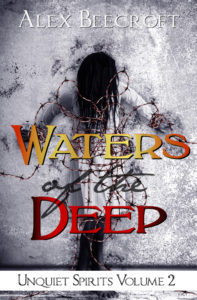5 Reasons to love the 18th Century
My new novella, ‘Waters of the Deep‘ is coming out tomorrow.
It’s a gay historical supernatural murder mystery set in the 18th Century, and I’ve noticed that when I say this to people they generally reply “oh, right; the Regency period.”
While I would certainly like to read Pride and Prejudice, the GBLT version – where Darcy and Bingley end up together – the Regency is very different in terms of dress and social mores from the 18th Century proper. The French revolution 1789-1799 may have lasted only 10 years, but it made a huge impact on the culture of the time. In Britain, at least, society became much more anxious, much more inclined to self-discipline and morality, self restraint and prudishness – as if by being conventionally virtuous they could stop the same thing from happening there.
Before the French Revolution, British society had been noisy, bumptious, rude and confident. You see a glimpse of it in Jane Austen with all those crass, vulgar, big-hearted old people who embarrass their more refined children and grandchildren. In Patrick O’Brien’s series of sea-faring novels set in the Napoleonic era, Jack Aubrey’s father, who damages Jack’s prospects of promotion by being loud and annoying in parliament, and damages Jack’s prospects of inheritance by marrying his chambermaid, is also a nod to the livelier, cruder days of the 18th Century proper.
Five reasons to Love the 18th Century.
- Start shallow and work up 😉 The clothes! This was probably the last period in history when men were allowed to be as gorgeous as women.
http://www.antoinettescloset.com/realmenscloths.htm
This is the era of the poet-shirt with the big baggy sleeves and the neckline down to the navel, with or without ruffles or lace, as you prefer. Rich men wore multi-coloured silk outfits with wonderful embroidery, contrasting waistcoats and knee breeches with fine silk stockings underneath. Poor men wore the classic highwayman/pirate outfits complete with tricornered hats. Did you know that a good calf on a man’s leg was considered such a desirable form of beauty that some men stuffed calf-enhancers made of cork down there?
- Pretty deadly gentlemen. The nice thing about all this male peacock display is that it could not be taken for a sign of weakness. All these gorgeously plumed lads had been training to fence and fight and ride and shoot since they were old enough to stand up. Ever seen ‘Rob Roy’ where Archie Cunningham slices and dices Liam Neeson as Rob Roy, while wearing an immaculate ice-blue waistcoat and extravagant Belgian lace?
There’s something very attractive about a class of men with Archie Cunningham’s ruthless intelligence, masterly swordfighting skills and love of expensive tailoring, but with the ‘evil bastard’ gene turned down a little. One of my heroes in the Unquiet Spirits series – Charles Latham – teeters on the edge of that refined man of honour/dangerous sociopath divide. He is less murderous than simply spoiled, privileged and entitled, but at times it’s a struggle not to want to box his ears. Bless him.
- Science!
For the first time in history ships and the provisioning of ships had advanced to the point where navigation was relatively reliable. Enough food and water could be stored aboard so that voyages could continue for months or even years at a time. From the perspective of the West, this was an age of exploration and discovery, when the old superstitions of the past were for the first time being investigated to see how much was true about them. In Jasper and Charles’s world they are rather more true than in our own.
- Filth, pamphlets and pornography.
Unlike Jane Austen’s time, when a well brought up young woman could be horrified by the idea of acting in a play, or writing to a young man who was not her fiancé, the 18th Century was much more… robust. Filthy, in fact. Literally filthy – streets full of horse manure and dead dogs, through which live cattle were lead to slaughter at the markets every morning (sometimes escaping to break into banks and terrorise the bankers). But also redolent with filthy language; swearing, f’ing and blinding, referring to a spade as a spade, and various bodily functions by their Anglo-Saxon names. The 18th Century style of vocabulary in a gentleman’s coffee house would be too crude for me to subject refined persons of the 21st Century to. But because of this overabundance of filth you do also get a great sense of vitality and humour, of people who are unashamed and determined to squeeze the last particle of enjoyment out of the world. People who cannot be cowed. Their pornography reflects this; bumptious but strangely innocent (or perhaps just plain strange.) Very much not safe for work link: http://joyful-molly.livejournal.com/57556.html#cutid1
5. The Gay Subculture.
By the early 18th Century urbanization had reached a point in London that there were enough gay people in one place to begin to recognise each other and form a subculture of their own. There were well known cruising spots such as the Inns of Court, Sodomite’s Walk in Moorfields or Birdcage Walk in St. James’ Park. The technical term for homosexual people at the time was ‘sodomites’ but they called themselves ‘mollies’, and there were molly houses where they could go to meet up and ‘marry’. Famous mollies like ‘Princess Seraphina’ – a London butcher – spent a great deal of time in drag. He seems to have been accepted into his community without a lot of fuss, as there are records of him dropping round to his female neighbours’ houses to have a cup of tea and borrow their clothes.
I really recommend Rictor Norton’s ‘Mother Clap’s Molly House’ http://www.rictornorton.co.uk/ as a great guide to that culture; scholarly but easy to read, generous and fascinating. So fascinating I had to set at least one of my stories around a fictional molly house in Bermuda. That’s Desire and Disguise, in the ‘I Do’ anthology, in which an unwary straight guy stumbles into the house by accident and gets a little more than he bargained for. You might also be interested in this ‘choose your own adventure’ site:
http://www.umich.edu/~ece/student_projects/forbidden/index.html
Mother Clap’s molly house, you’ll be relieved to know, was so called because it was run by a gay friendly lady called Margaret Clap, not because that was something you were likely to get there!
In short, the 18th Century in which the Unquiet Spirits series was set could not be more different than the prim and refined era of the Regency novel. I can’t offer a comedy of manners, only a fair degree of lust and violence, badly behaved ghosts, bad language, and dangerous men in gorgeous clothes. But if you enjoyed The Wages of Sin, this is both more of the same and something a little bit different. I hope you enjoy it!

